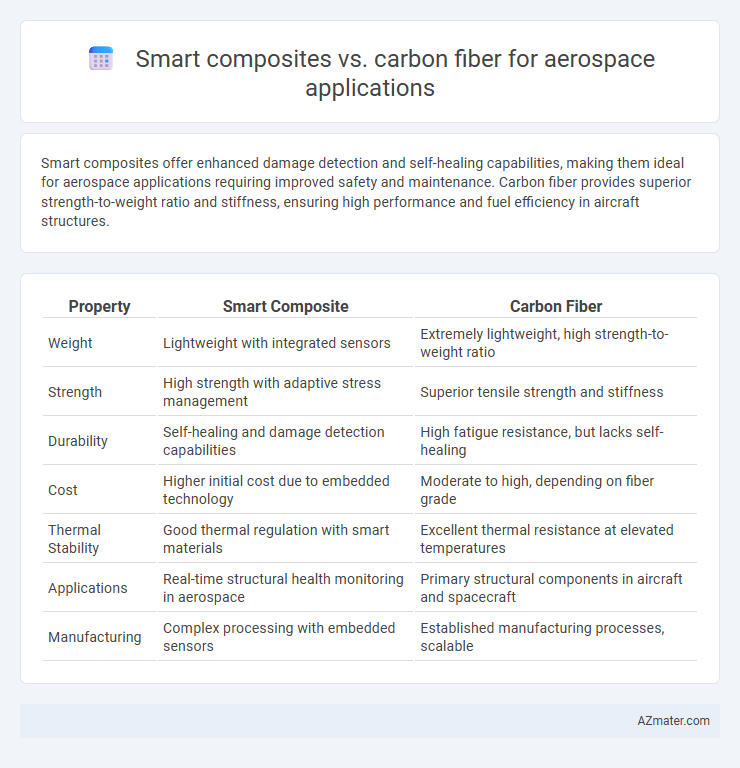Smart composites offer enhanced damage detection and self-healing capabilities, making them ideal for aerospace applications requiring improved safety and maintenance. Carbon fiber provides superior strength-to-weight ratio and stiffness, ensuring high performance and fuel efficiency in aircraft structures.
Table of Comparison
| Property | Smart Composite | Carbon Fiber |
|---|---|---|
| Weight | Lightweight with integrated sensors | Extremely lightweight, high strength-to-weight ratio |
| Strength | High strength with adaptive stress management | Superior tensile strength and stiffness |
| Durability | Self-healing and damage detection capabilities | High fatigue resistance, but lacks self-healing |
| Cost | Higher initial cost due to embedded technology | Moderate to high, depending on fiber grade |
| Thermal Stability | Good thermal regulation with smart materials | Excellent thermal resistance at elevated temperatures |
| Applications | Real-time structural health monitoring in aerospace | Primary structural components in aircraft and spacecraft |
| Manufacturing | Complex processing with embedded sensors | Established manufacturing processes, scalable |
Introduction to Advanced Materials in Aerospace
Smart composites integrate sensors and actuators within advanced fiber-reinforced matrices, enabling real-time structural health monitoring and adaptive response in aerospace applications. Carbon fiber composites offer exceptional strength-to-weight ratios and stiffness, making them the preferred material for primary load-bearing structures in aircraft and spacecraft. The fusion of smart composite technology with traditional carbon fiber enhances both performance and safety by combining durability with intelligent functionality in aerospace design.
Defining Smart Composites and Carbon Fiber
Smart composites integrate sensors, actuators, and advanced materials to enable adaptive responses in aerospace structures, enhancing performance through real-time monitoring and self-repair capabilities. Carbon fiber composites consist of high-strength carbon fibers embedded in a polymer matrix, offering exceptional stiffness-to-weight ratio and corrosion resistance critical for aerospace applications. Combining the adaptability of smart composites with the structural benefits of carbon fiber optimizes aircraft durability, efficiency, and safety.
Structural Properties Comparison
Smart composites exhibit adaptive structural properties through embedded sensors and actuators, enhancing damage detection and load management in aerospace applications. Carbon fiber offers superior stiffness-to-weight ratio and high tensile strength, making it ideal for primary load-bearing components requiring minimal deformation. While carbon fiber excels in static strength, smart composites provide multifunctional capabilities, improving structural health monitoring and extending aircraft lifecycle.
Weight Reduction Capabilities
Smart composites integrate responsive materials that adapt to environmental stimuli, offering tailored performance and enhanced weight reduction in aerospace structures. Carbon fiber composites exhibit superior strength-to-weight ratios, significantly decreasing overall aircraft mass while maintaining structural integrity. Combining smart composite technologies with carbon fiber matrices further optimizes weight savings and improves the efficiency of aerospace components under dynamic operating conditions.
Durability and Fatigue Resistance
Smart composites integrate embedded sensors and adaptive materials, enhancing durability by actively monitoring and responding to stress, which significantly improves fatigue resistance in aerospace applications. Carbon fiber composites provide exceptional strength-to-weight ratios and inherent fatigue resistance, but lack the autonomous damage detection capabilities of smart composites. In high-performance aerospace structures, the choice depends on balancing carbon fiber's proven fatigue longevity with smart composites' real-time durability monitoring for optimized lifecycle management.
Real-Time Monitoring and Self-Healing Features
Smart composites integrated with embedded sensors provide real-time structural health monitoring in aerospace applications, enabling continuous data acquisition on stress, strain, and damage development. Carbon fiber composites, renowned for their high strength-to-weight ratio, can be enhanced with self-healing polymers or microcapsules to autonomously repair microcracks, improving durability and safety. Combining these technologies in aerospace materials advances aircraft maintenance by reducing downtime and extending service life through proactive damage detection and autonomous repair mechanisms.
Cost and Manufacturing Considerations
Smart composites offer adaptive properties by integrating sensors and actuators, enhancing real-time performance monitoring in aerospace applications, though their manufacturing processes tend to be more complex and costly than conventional carbon fiber composites. Carbon fiber composites remain favored for aerospace due to their high strength-to-weight ratio and relatively mature, cost-effective manufacturing techniques like automated fiber placement and resin transfer molding. Cost considerations highlight carbon fiber as more economical for large-scale production, whereas smart composites, despite higher initial expenses, provide added functionality that can reduce maintenance and operational costs over an aircraft's lifecycle.
Performance in Extreme Flight Conditions
Smart composites exhibit enhanced adaptability and damage sensing capabilities, crucial for withstanding extreme flight conditions such as high turbulence and rapid temperature changes. Carbon fiber offers exceptional strength-to-weight ratio and stiffness, ensuring structural integrity in high-stress environments typical of aerospace applications. The integration of smart composite materials provides real-time monitoring and increased resilience, potentially surpassing traditional carbon fiber performance in durability under dynamic flight stresses.
Sustainability and Lifecycle Assessment
Smart composites in aerospace integrate sensors and adaptive materials, enhancing structural health monitoring and reducing maintenance costs compared to traditional carbon fiber composites. Carbon fiber offers high strength-to-weight ratios but presents challenges in recyclability and energy-intensive production processes, impacting overall lifecycle sustainability. Lifecycle assessment highlights smart composites' potential for improved end-of-life recyclability and reduced environmental footprint, making them a promising alternative for sustainable aerospace engineering.
Future Trends in Aerospace Material Innovation
Smart composites in aerospace integrate embedded sensors and adaptive properties, enabling real-time structural health monitoring and damage response, whereas traditional carbon fiber composites offer high strength-to-weight ratios critical for airframe performance. Future trends emphasize multifunctional materials combining lightweight carbon fibers with smart capabilities to enhance fuel efficiency, reduce maintenance costs, and improve safety in next-generation aircraft. Advanced manufacturing techniques like automated fiber placement and additive manufacturing will accelerate the adoption of hybrid smart composite systems, driving innovation in aerospace material science.

Infographic: Smart composite vs Carbon fiber for Aerospace application
 azmater.com
azmater.com